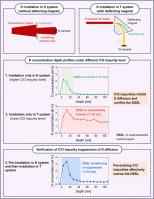C/O杂质在抑制氘扩散和钨中过饱和层中的关键作用
IF 9.3
1区 材料科学
Q1 MATERIALS SCIENCE, MULTIDISCIPLINARY
引用次数: 0
摘要
D辐照下钨(W)中氘过饱和表面层(DSSL)的形成是影响等离子体材料(PFMs)缺陷演化和燃料保留的关键现象。然而,普遍存在的C/O杂质在DSSL发展中的作用仍然没有得到充分的阐明。本研究通过采用两种不同的D离子束系统,系统地研究了C/O杂质和D辐照条件对DSSL的影响:标准考夫曼源(K系统,固有C/O)和磁过滤高纯度源(T系统)。x射线光电子能谱证实T体系的C/O共注入明显降低。弹性反冲检测分析显示,在K体系中形成的DSSL很窄(~ 27 nm),而在T体系中形成的DSSL则宽得多(>110 nm)。低杂质T体系中的这种展宽归因于D的无阻碍扩散,而K体系中的C/O杂质抑制了D的扩散,限制了DSSL。顺序辐照实验——k体系预辐照后再进行T体系辐照——证实了预先存在的C/O杂质有效地缩小了DSSL,挑战了DSSL形成完全由d驱动的传统观点。虽然C/O杂质限制了DSSL的展宽,但这种影响随着D通量和流量的增加而减弱。在没有明显的C/O干扰的情况下,DSSL浓度和总D保留率更依赖于D通量而不是通量。这项工作提出了C/O杂质在决定DSSL形态中的关键作用,并提供了DSSL固有行为的基准数据,为理解聚变环境中氘-物质相互作用提供了重要的见解。本文章由计算机程序翻译,如有差异,请以英文原文为准。

Critical Role of C/O impurities in suppressing Deuterium diffusion and supersaturated layers in Tungsten
The formation of deuterium supersaturated surface layers (DSSL) in tungsten (W) under D irradiation is a critical phenomenon influencing defect evolution and fuel retention in plasma-facing materials (PFMs). However, the role of ubiquitous C/O impurities in DSSL development remains insufficiently elucidated. This study systematically investigated the impact of C/O impurities and D irradiation conditions on DSSL by employing two distinct D ion beam systems: a standard Kaufman source (K system, with inherent C/O), and a magnetically filtered high-purity source (T system). X-ray photoelectron spectroscopy confirmed significantly lower C/O co-implantation from the T system. Elastic recoil detection analysis revealed that DSSL formed in the K system were narrow (∼27 nm), whereas those in the T system were substantially broader (>110 nm). This broadening in the low-impurity T system is attributed to unimpeded D diffusion, while C/O impurities in the K system inhibit D diffusion, confining the DSSL. Sequential irradiation experiments—K system pre-irradiation followed by T system irradiation—confirmed that pre-existing C/O impurities effectively narrow the DSSL, challenging the conventional view that DSSL formation is solely d-driven. While C/O impurities restrict DSSL broadening, this effect diminishes with increasing D flux and fluence. In the absence of significant C/O interference, DSSL concentration and total D retention were found to be more strongly dependent on D fluence than flux. This work presents the crucial role of C/O impurities in dictating DSSL morphology and provides benchmark data on intrinsic DSSL behavior, offering vital insights for understanding deuterium-material interactions in fusion environments.
求助全文
通过发布文献求助,成功后即可免费获取论文全文。
去求助
来源期刊

Acta Materialia
工程技术-材料科学:综合
CiteScore
16.10
自引率
8.50%
发文量
801
审稿时长
53 days
期刊介绍:
Acta Materialia serves as a platform for publishing full-length, original papers and commissioned overviews that contribute to a profound understanding of the correlation between the processing, structure, and properties of inorganic materials. The journal seeks papers with high impact potential or those that significantly propel the field forward. The scope includes the atomic and molecular arrangements, chemical and electronic structures, and microstructure of materials, focusing on their mechanical or functional behavior across all length scales, including nanostructures.
 求助内容:
求助内容: 应助结果提醒方式:
应助结果提醒方式:


